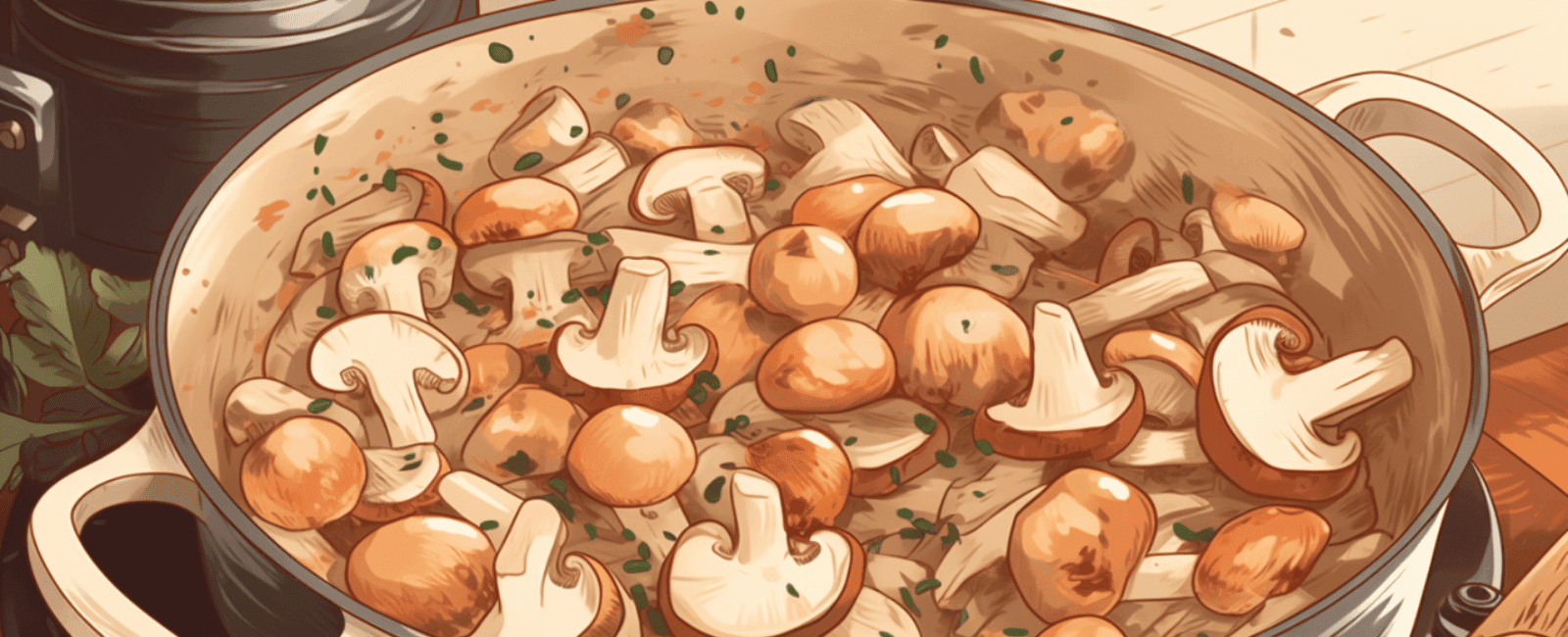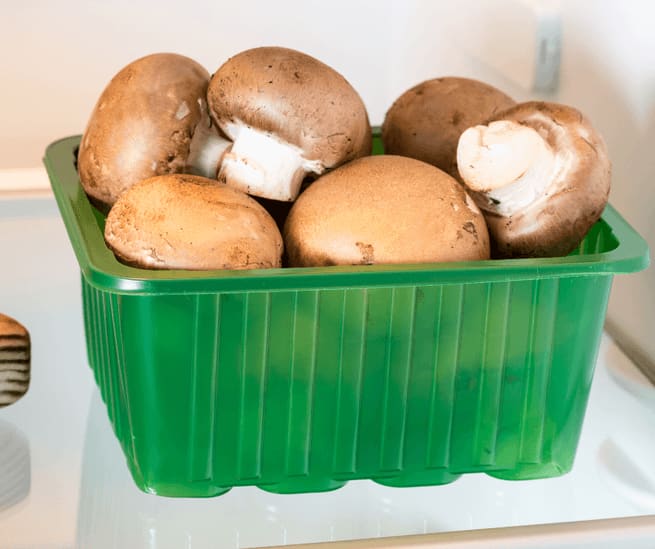

There are so many different ways to eat mushrooms. With their unique flavors and textures, mushrooms are cherished ingredients used as a staple food by many cuisines across the world. As an appetizer, side dish, or main course, knowing how to cook mushrooms is an important kitchen skill to have. And there are as many ways to cook them as there are to eat them!
Mushrooms come in a wide range of varieties. Your senses interact with each one differently since they all have varying shapes, sizes, scents, textures, and colors. Those characteristics affect the flavor, mouthfeel, and aroma of the ingredient you choose. Different cooking methods can bring out different aspects of a mushroom. There’s a lot to learn, so sharpen your knives and grab your aprons.
Why cook mushrooms?

If it’s your first time attempting to prepare mushrooms, you may be wondering why you should cook them at all. Reasonable. Adding a new ingredient to the shopping list, in this economy?
Point blank, mushrooms are delicious. They are packed with a series of flavor compounds that, when eaten, produce what’s called the fifth taste, or “umami.” (The other four tastes are sour, salty, bitter, and sweet).
Umami is that savory, meaty, earthy flavor. So, when you add mushrooms to a meal, you automatically introduce a food that’s going to bring rich, deep characteristics to your dish. Besides tasting awesome, mushrooms are also a superfood in terms of nutritional value.
Mushroom nutritional information
Although different types of mushrooms have varying nutrients, Medical News Today reports that mushrooms are generally a healthy food to eat. In terms of nutritional worth, common grocery varieties (like shiitake or cremini mushrooms) have loads of vitamin B, vitamin C, and vitamin D, too.
In addition to those important factors, many mushrooms are high in essential minerals like calcium and potassium while being a low-fat, low-carbohydrate food. Some research suggests that a type of fiber in mushrooms can lower cholesterol.
The USDA considers mushrooms in the same food group as veggies. For the most part, you can cook them the same way as your favorite garden produce. Still, there are some specifics to consider.
Main cooking methods for mushrooms

There are several main cooking processes for fresh mushrooms: sautéeing, grilling, frying, and roasting are the big four to focus on. The prep time and final food form will differ for all of them, but each is equally delicious.
Before you’re ready to cook mushrooms, you must prepare them for the kitchen. A clean mushroom is a happy mushroom. But, unless you’re bringing in foraged wild mushrooms, it’s not always necessary to wash that package you picked up from the store, per Cook’s Illustrated.
In fact, washing mushrooms can make your cooking harder.
Fungi with gills, like oyster mushrooms, can absorb water when you rinse them, leaving them potentially soggy and slimy. Instead of running them under water, use a damp paper towel to gently rub away any dirt or blemishes.
Once you have your mushrooms cleaned, you’re ready to go. Start by checking if your recipe calls for whole, cubed, or sliced mushrooms, and get chopping!
How to sauté mushrooms
Sautéeing is a simple technique that will allow you to cook mushrooms on the stovetop with a pan and a touch of oil.
The process is simple. Drip olive oil, garlic butter, or your preferred cooking fat in a pan, and turn on the temperature to medium-low heat. When the oil becomes loose and spreads, add your mushrooms. They can be sliced if you like, but smaller varieties like baby bella shrooms can also be cooked whole.
Turn your stove to medium-high heat. Keep an eye on the pan to make sure the mushrooms don’t stick, and stir occasionally. Adding basic seasonings like salt or black pepper is a must, but sprigs of fresh thyme or caramelized shallots are simple ways to elevate your mushrooms further.
After about five minutes, the texture should soften considerably. From here on out, your fungi can be considered cooked, simple as that!
One of the coolest cooking tips you may ever receive about sautéeing mushrooms is that it’s nearly impossible to overcook them, according to Tasting Table. Because of a tcompound called chitin in mushrooms, the cell walls remain firm under high temperatures. This means that the texture of a mushroom stays the same from five minutes of cook time onward since nothing is breaking down inside.
That said, it is possible to burn the skin of a mushroom from too much heat, so make sure not to put your stove on too high! From morels to chanterelles and store-bought white button mushrooms, nearly every variety will cook well when sautéed. This is the best method if you’re looking to add cooked mushrooms to stir-fries, risotto, or even omelets.
How to grill mushrooms
Grilling mushrooms requires a bit more attention than sautéeing. The difference between a cooked mushroom and a burnt mushroom can be only a few seconds in total time on the grill.
There are two main ways to grill a mushroom. One is direct contact with the grill grates, similar to how you would prepare chicken breast. It requires constant attention and quick placement to avoid having your mushrooms stick. An oil rub or marination for your mushrooms helps too.
Because of the general size and alignment of grill grates, it’s best to choose larger-sized fungi, such as full-grown portobello mushrooms, for this method. You’ll want to cut the woody stem, scrape out the gills, and consider stuffing them with a mix of aromatics, cheese, and spices for an extra-delicious touch. If cooking stuffed mushrooms, ensure your food is not cooked on direct fire. For fresh fungi without filling, cooking over direct heat is fine so long as you flip often.
If all you have on hand is small mushroom varieties, a grill basket can come in handy in keeping things in place, but if the grates are narrow enough, they’re probably also safe for direct placement.
The other grilling method for mushrooms is kebab-style. Here, you’ll use water-soaked sticks to pierce several mushrooms at once, then place the whole spear over indirect heat. The soaked sticks work to steam your shrooms from the inside as the grill adds a nice char. Kebabs are a little easier to maneuver, but you should still mind the skin-to-grill contact.
The time needed for grilling mushrooms can be different depending on your equipment and if you stuffed, marinated, or speared your mushrooms. Fortunately, whatever grilling method you’ve chosen, the signs of doneness are the same.
Smell first. Are your mushrooms giving off an acrid odor, or is the scent inviting? Next, look at the texture. Have the mushrooms softened slightly? If so, you’re probably closer than you think. Finally, check the skin of the mushrooms. Slightly browned and crisp, not blackened, is your ticket.
How to fry mushrooms
If you find yourself craving a crispy, crunchy snack but really want something that isn’t nutritionally void, fried mushrooms are the answer.
You can fry mushrooms the old fashion way (in a tall pot with simmering oil) or in an air-fryer. Dealers choice! However you choose, you’re in for a treat. Both methods start by making sure your mushrooms are very dry.
Fried mushrooms require a bit of batter, which you can make with a mix of corn flour, salt, parmesan, and bread crumbs. (Gluten-free works great, too!) Use an egg wash to dip your shrooms before coating them in the batter to ensure everything sticks.
If you’re doing a home deep fry, make sure you’re using a pot with high walls and give your oil about 15 minutes to get sizzling hot. You should use enough to be able to completely soak the mushrooms. Work in batches, slowly dropping the mushrooms in the hot oil and straining them out when golden brown. A mushroom should typically be cooked in about 5 minutes.
For deep frying, medium-density mushrooms work the best. Thin-fleshed varieties (like oysters and chanterelles) take on a floppier texture.
To keep your mushrooms closer to their healthy reputation, use an air fryer instead of hot oil. You can batter your shrooms or cook them lightly tossed in oil. Place a single layer of mushrooms in your air fryer for optimal airflow. In about 15 minutes at medium heat, you should have a delicately crispy snack.
Whether dipped in oil or air-fried, a squirt of lemon juice helps to cut through the thick salinity of your crunchy batter.
How to bake or roast mushrooms
The easiest way to cook mushrooms? Bake them in the oven. Mushrooms can be roasted at 350 to 400 degrees Fahrenheit for anywhere between 15 to 45 minutes, depending on how much time you have. The result is a low-carb dish with grounded, meaty flavors — and it’s too easy to cook.
Preheat your oven while you’re prepping your mushrooms. Make sure that your shrooms are clean, woody stems are removed, and any gnarly gills are scraped out.
If there’s a sauce you love, toss your mushrooms in it. Pour them into a single layer on a baking sheet or low casserole dish. Don’t have a ready-made dressing? No worries. Toss your fungi in a bit of oil, and add salt, pepper, garlic powder, and dried parsley. It’s a simple and winning combo. Spread your mixture on a baking sheet, and let the oven do the rest.
When roasting mushrooms, nearly any addition goes. Coat them in soy sauce or teriyaki; add freshly sliced onion and pepper — whatever you do, check in every 15 minutes to confirm the heat isn’t too high and your mushrooms have not shriveled or blackened.
Keeping mushrooms in your kitchen

You’ve done it. A fresh batch of mushrooms is coming home, and you’re ready to cook them. Apart from preparation, it’s crucial to know how to store your ingredients to maintain top condition. Many mushroom varieties are not cheap!
Can you freeze mushrooms?
It’s absolutely possible to freeze mushrooms. First, scrub them clean and dry.
If you’re storing raw ones, you’ll want to freeze them at their peak freshness. Freezing raw shrooms can get a little tricky since they have a high water content that can result in soggy shrooms once defrosted. To reduce the chance of that happening, seal them in an airtight bag, like a Ziploc.
You can also pre-cook mushrooms before you freeze them. This serves several purposes. The technique of blanching (quickly boiling and then immediately cooling) can retain nutrients in frozen mushrooms.
Similarly, sautéeing, roasting, or grilling mushrooms won’t retain as much nutritional value but will help your mushrooms hold up well and provide a quick, flavorful dinner. According to Food Network, mushrooms last up to nine months in the freezer.
Cook mushrooms directly from frozen to steam off any leftover moisture. Even vacuum-sealed mushrooms will become a bit softer, so these are better used in soups, stews, or oven-bakes.
How to tell if mushrooms are bad
To tell if a mushroom has gone bad, use your senses. Does it have any discoloration or dark spots? This is a tell-tale sign of mushrooms gone moldy. Similar signs of spoilage are mushy or slimy mushrooms, an earthy smell that’s become funky, and a spongey bottom.
Food safety is important. Bad mushrooms are capable of causing food poisoning. Fortunately, with the correct storage methods, you can make the most out of your groceries. Start by finding a new home for your fungi beyond the crisper drawer. The glass ceiling is meant to keep greens fresh but results in too much excess moisture for fungi.
Always remove your mushrooms from plastic wrap and cover them with a paper towel, storing them towards the front of the fridge. This ensures that they won’t become damp and begin spoiling.
Can you eat raw mushrooms?
The answer to this question is not as decisive. Edible varieties of mushrooms like shiitake, enoki, and even the big boss portobello can be eaten raw. However, it’s not recommended for most types.
As previously mentioned, mushroom cell walls are full of chitin. The human digestive system cannot break this compound down. Applying high heat can. So, eating raw mushrooms can result in stomach discomfort, while cooking them makes digestion more simple. Not to mention, types of mushrooms like oysters, lion’s mane, or morels just have a bad texture when consumed raw.
That said, some varieties are better than others. White button mushrooms and baby bellas are both safe varieties to serve thinly sliced with salad or another appetizer.
Do mushrooms have protein?
Selenium, potassium, and antioxidants — there are a lot of benefits to eating mushrooms. In particular, mushrooms are a reliable source of low-calorie protein, albeit not one that is considered an especially “high protein content” food source. In general, most mushrooms contain anywhere between 2 to 3 grams per 8-ounce serving.
Still, that alone shouldn’t stop you from eating mushrooms. The upside of mushroom benefits are things like beta-glucans, which have been linked to improved immune system functions.
Consider cooking mushrooms for your next meal
Overall, knowing how to cook mushrooms is invaluable if you’re looking to add a new ingredient that is both delicious and healthy to your kitchen. Start off with these easy-to-follow chestnut mushroom recipes, and grow from there. Bon appétit!


